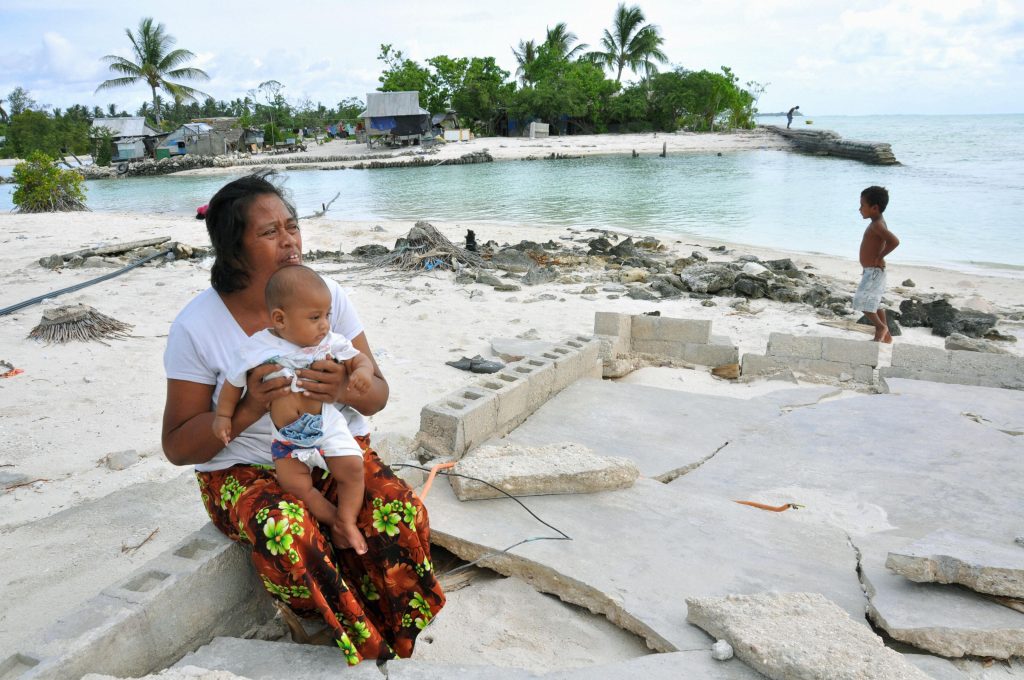“The Anthropologist” Isn’t Another Climate Change Horror Flick

The Anthropologist, 78 minutes, directed by Seth Kramer, Daniel A. Miller, and Jeremy Newberger
Katie Yegorov-Crate is the young daughter of Susan Crate, a renowned environmental anthropologist at George Mason University. She’s also the somewhat unwilling star of The Anthropologist, a new documentary about her mother’s work, which she cheekily but accurately characterizes in teen argot. “Siberia is intense, yo,” she says. The line gets a laugh—but it’s also accurate. The village is a world away from her daily routine in suburban Virginia.
Over the course of the film, Yegorov-Crate matures from an eye-rolling 14-year-old to a thoughtful college freshman. Alongside her mother, she visits a Siberian village that rests on quickly melting permafrost. She catches a boat to the tiny Pacific island nation of Kiribati, where rising seas have swallowed up villages and coconut plantations. And she gets altitude sickness in the Peruvian Andes, where she sees firsthand what’s left of glaciers that have crawled backward up the mountains.
We see all these things through Yegorov-Crate’s young eyes. She is our surly, charming, stand-in—the natural anthropologist watching her professional anthropologist mother, in classic participant-observation style, interviewing local people, helping with their daily work, and celebrating with them during social occasions.
The Anthropologist is a film about cultural anthropology—how it is done, why people do it, and what it looks like on a day-to-day basis. It is also a film about climate change’s effects on non-Western cultures. And it is a film about mothers and daughters, about growing up and deciding what path to take in life.
And yet, despite being concerned with these undeniably weighty topics, the film feels light, almost slight. It is loosely constructed, unhurried, and without scaffolding. There is no narrator to tell you what everything means—though there are a series of sometimes cryptic observations about anthropology from Mary Catherine Bateson, the daughter of the late, great cultural anthropologist Margaret Mead, to consider. (We also get some fun vintage footage of Mead in the field.) There is no clear thesis statement—rather, there are scenes, songs, and jokes. This looseness, lightness, and openness may be, in the end, the most effective thing about the film. It feels like real life because it is real life.
Plenty of films have tried to capture the urgency, complexity, and reality of climate change, from former Vice President Al Gore’s 2006 An Inconvenient Truth to this year’s Before the Flood, presented by teen heartthrob turned serious-liberal-and-serious-actor Leonardo DiCaprio. Most of these films aim to present climate change in its entirety—and to terrify or shock audiences with the immensity of the threat. They have action film–style musical scores and inevitably feature intense sequences of hurricanes destroying houses and glaciers crashing into the sea.
The sheer enormity of these documentaries may be part of the reason why they haven’t yet seemed to usher in major changes in humanity’s behavior. As climate change communication specialist Susanne Moser has written, stimulating intense emotions like fear and guilt about climate change can lead to numbness. All those heart-pounding sound effects and scenes of people watching their homes wash away intercut with grim charts and statistics lead not to action but to a sick, overwhelmed feeling that sends viewers straight from the movie theater to their beds, where they slip under the covers with a tub of rocky road ice cream.
In its much more quiet way, The Anthropologist does not take on all of climate change or terrify its viewers with footage of glaciers falling into the sea. Instead, it makes climate change feel very personal.
It introduces us to a farmer who can no longer grow the potato known as puma’s claw because of environmental changes. We meet a woman who is trying to teach the people of Kiribati, the I-Kiribati, about climate change and their options as the sea rises.
But these people are not shown only as victims, screaming with terror or clinging to trees as the water rises around them. They are depicted as everyday people. The I-Kiribati climate activist in the film braids Yegorov-Crate’s hair and teaches her some local tunes. The Andean farmers celebrate a local holiday with glacier-ice snow cones. The Siberian farmers take Yegorov-Crate on rides in the sidecars of their motorcycles.
In essence, the film does what the cultural anthropology of climate change also seeks to do: It humanizes those affected, telling their stories in detail and with compassion. You can tell people that by 2030 climate change and the use of fossil fuels will cause 6 million deaths annually, or you can argue that 760 million people might be displaced by rising seas, as recent news stories have done. Readers and viewers will say, “That’s horrible,” and find themselves feeling paralyzed and numb. Or you can, as The Anthropologist does, spend a few moments with a single affected person and invite viewers to look into his eyes and listen as he says, “When the land is broken, there is a shaking in the heart.” The latter invokes empathy, not horror.
Near the end of the 78-minute film, Crate talks about the “cultural transformations” she is documenting as societies around the world adapt to the changing climate. We see that the Peruvian farmers are diversifying into aquaculture to compensate for their lost crops. In Kiribati, there is talk that the transformation may require physical relocation, even though that puts their local culture at risk.
The people Crate studies probably don’t need saving; they are already saving themselves. With a few scenes from a protest at the White House against the construction of an oil pipeline, the film hints that perhaps, slowly, one Prius and demonstration and fuel-efficiency standard at a time, our Western industrialized culture is going through its own cultural transformation. “I don’t really think we can change the world,” Crate says. “I think we change, and that changes the world.”
Ultimately, The Anthropologist isn’t a film about how to solve climate change. Nor is it designed to convince us climate change is real or to beat its urgency into our heads. It is a film with a few memorable stories about how the shifting climate is affecting humans on Earth. And it is about the value of those stories. By the end, we are not terribly surprised when the daughter goes off to college to pursue a path similar to her mother’s. Like her, we’ve become convinced of the importance of collecting and telling the stories of people whose lives and cultures are being reshaped by climate change.
































